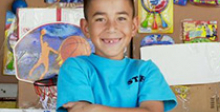Internal mini form
Contact Us Today
When a parent notices a child having difficulty relating to peers, it’s often more painful than if they were going through it him or herself. Luckily, parents have a lot of leeway in terms of helping their child not only gain acceptance from others; they also have the ability to influence their child’s self-image.
Ten tips for parents
It’s a situation that occurs to most parents when they send their child to school: What if my son or daughter doesn’t fit in?
For parents, it’s typically inconceivable that their child would not be accepted by others. After all, why in the world wouldn’t other children want to be around such a bright, engaging child?
Although many parents are faced with the prospect of a child that has difficulty gaining acceptance from peers, those who have children with special needs cope with a different set of circumstances. Their child is already likely overcoming many obstacles presented by his or her health conditions and all that comes with it, such as medical appointments, interventions, special education, and work arounds for daily acts of living. Add in the fact that they may walk different from other children, communicate differently, or use assistive equipment, and child can struggle through social development.
If a child can’t find some common ground with other young people, feelings of isolation can last well into adulthood. This can affect how they cope with friends, neighbors, co-workers – all relationships that require social acumen that they may not have had a chance to hone.
But this unfortunate situation can be avoided if parents employ some methods designed to give their child an opportunity to reach out to others. Here are 10 tips to help a child enter adulthood with confidence in their ability to engage with others.
1. Find social opportunities early, and often.
One way children can meet potential friends and begin the process of socialization is through activities and interaction with their peers. Find activities that a child may enjoy and that fit into his or her skill set. The simple process of getting to know other people through engagement and common interests helps the child see that he or she is capable of making friends. This serves as a powerful lesson going forward because a child will be less likely to develop social anxieties that can derail adult relationships down the line. For guidance with age-appropriate social development, read Erik Erikson’s Theory on Psychosocial Development.
2. Make sure activities include able-bodied children and adults.
It’s great to participate in activities that include other children with disabilities because it helps children realize that they’re not alone. But as they grow up, more able-bodied people will enter their world.
Able-bodied children and adults often have some anxieties about children with disabilities because they have questions about it, but it is immensely beneficial to all children to see that they’re alike in many ways – even if some people interact differently. Able-bodied people will eventually become co-workers and bosses, and hopefully, friends. It’s a good idea to mix up a child’s company, so he or she develops socially acceptable forms of interaction.
3. Tell a child how much he or she has in common with others.
A child with a disability is likely to feel that he or she is so different from other children that there’s no way they could be friends with them. In this case, the child needs to hear about what makes them similar to other children. For instance, a child may be obsessed with a teen idol. It stands to reason that other children would be, as well. Point this out to the child. This will help them feel as if the chasm between his or herself and others is more navigable and less imposing.
4. Cultivate a child’s interests.
If a child develops and interest, it’s an opportunity to be social for children. The best thing about interests is that they often carry forward into adulthood – this can give a person with disabilities a lifetime of opportunities to meet and converse with others. If a child stays at home, and only takes part in solitary pursuits, he or she will not have those opportunities. Find clubs, troupes, and classes – anything that will pry a child from his or her shell. Experimenting with interests is not only fun, it lends to a sense of mastery and accomplishment. Having confidence in one’s abilities helps to develop self-worth, self-image, and self-identity. These three concepts of self bode well when interacting with others. If one accepts oneself, it is easier for others to accept them, as well.
5. If a child rejects your child, it’s his or her problem.
Rejection is a part of life for everyone, not just people with disabilities. It’s something that will happen to everyone, multiple times, throughout a lifetime. It’s natural that someone with disabilities would believe the rejection occurred because he or she has a disability, but that’s not always the case. Let a child know that when rejection occurs, it’s more about the other person than it is about them. At these times, reinforce in your child a sense of their self-worth. For example, simply stating, “Their loss” can do wonders. Or, “That’s a shame, they really could have had a wonderful friend in you, if they would have taken the time to understand you better.” This establishes the rejection towards the misunderstanding, and not a rejection of your child.
6. Consider a child’s true identity.
When a person’s identity is built around their disability, it leaves little room for that person to see themselves as anything else but a person who is different. People cope better with hardships such as disabilities if they can see beyond labels. A person may have a disability, but perhaps they are a soccer player, a father or mother, a flute player, or a chess aficionado. If a person sees their disability as part of another whole, it provides much-needed perspective.
7. Establish limits.
All children need limits. In an attempt to fit in with other children, a child may want to take part in activities that are not safe, or are otherwise unreasonable. Setting limits will help children understand that relationships – especially those that begin in childhood – should be unconditional and free of pressure within reasonable limits. Be careful, though, not to underestimate your child’s ability to achieve beyond your perception of their capabilities. Children never cease to amaze, especially those empowered to do so.
8. Focus on abilities.
A child’s disability may re-define aspects of their interactions with others. That alone is something that will make a child more noticeably different than his or her peers. They may have impaired speech, or move differently, have difficulty eating, or use assistive devices. But this doesn’t change a child’s capacity for interacting with others. They can still speak and express ideas in many cases. They may have limits on their movement, but they can still enjoy a beautiful day outside. When these commonalities are stressed at home, a person with disabilities can see themselves as part of a larger world with all types of people.
9. Talk to other parents.
Parents of children that live nearby or attend school with a child with disabilities may not know what the child’s capabilities are – so they are uncertain if they can tell their son or daughter it’s okay to be friends. Be sure to open up about the child to other parents – they are likely to become an encouraging force not only for another parent, but also another child. Taking the time to creatively educate others reaps many rewards.
10. Encourage a child to share his or her story.
A child with a disability may not feel comfortable talking about the nature of his or her disability. And, there may be subjects they may never speak about. But sharing how or why they have a disability, and showing that they are capable of speaking and relating to other children, shows everyone that a person who has disabilities is more like everyone else than different. That’s a message worth sharing over and over.

Acceptance
When a child with a disability reaches adulthood, feelings about acceptance by others may linger. If young people learn to accept themselves during their formative years, explore interests, form friendships, accomplish, interact, and socialize at age-appropriate stages, it can help empower a sense of belonging when they’ve grown.
Learn more
- About Acceptance
- Acceptance: Tips for Individuals with Cerebral Palsy
- Acceptance: Tips for Parents
- Acceptance: Tips for Teachers
- Inclusion
For more helpful tips, visit
Managing Cerebral Palsy and
Maximizing Potential.








